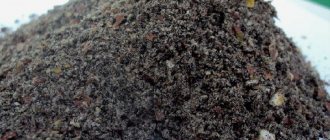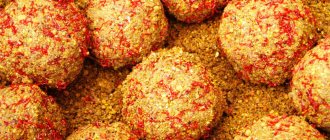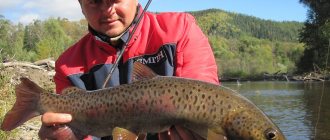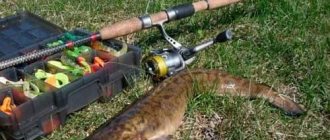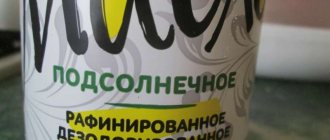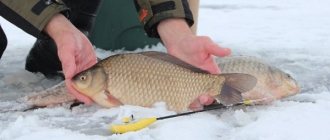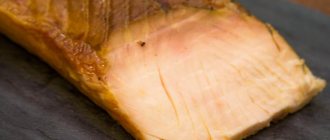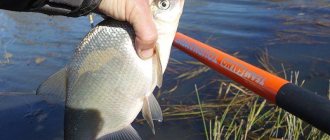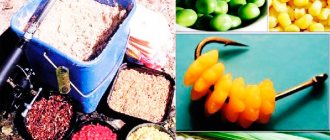Is late autumn almost early winter? Not so: recently our climate has warmed up so much that we already have to get used to the new reality - and in terms of weather, December is increasingly reminiscent of the last month of autumn. This means that in other years the autumn off-season can last as long as 60 days. And what should fans of float and feeder fishing do at this time? Sitting at home and being bored? Personally, I can’t go that long without fishing. And that’s why, whining to myself about the winter lost in God knows where, I go with my favorite gear to the shore of some body of water to thoroughly enjoy thoughtful and leisurely late-autumn fishing.
One of the main questions that I try to think about even before I start fishing is what and how much I will feed the fish. I confess honestly, this choice is difficult, and a small miscalculation in the composition or quantity of bait can be the cause of a complete fishing fiasco. Now I want to share with you my experience, as well as feeding methods, which, in my opinion, are the best solutions during this difficult time of year for fishing.
Or maybe not feed the fish at all?
Many of my colleagues in late autumn completely refuse bait or prefer to lure fish to the fishing point with clean sand. The logic of their reasoning is approximately as follows: since the fish practically do not feed at this time of year, they should not be overfed with bait.
It is much more effective to walk along the shore and look for points where fish have gathered in a school. And to mark the point where the hook with the nozzle is located, you can pour a handful of sand into the water. And you know, this simple trick sometimes works. But only if the main fish in the catch is bleak or small roach.
For the rest of the fish, river sand as bait turns out to be completely useless. As an experiment, I even flavored the sand with flavoring - the effect was zero. The result appeared when semolina or Hercules ground in a coffee grinder was added to the sand. But then the soil had to be considered as ballast.
However, let’s return to the second part of the technique described above, namely the active search for fish sites. In late autumn, when 90% of all fish living in a reservoir concentrate on 10% of its area, a skillful search for these sites is most effective. And at a well-chosen point, you will still see several bites without any feeding. But a float or bottom fishing rod is not a spinning rod, where the bait moves actively, and a roach or bream is not a perch that instinctively reacts to movement. And as soon as the unhooked members of the flock sense a catch, the bites will stop.
Only competition for food can renew the fish's interest in the bait, which correctly supplied bait helps to stimulate. So you need to feed the fish even in late autumn. Only this should be done extremely carefully.
Variety of fishing methods
Two methods of fishing are popular among domestic fishermen: float and bottom. Float tackle includes fly, Bolognese and match fishing rods. They differ in length, structure, presence and arrangement of rings.
Fly rod and lapdog
The swing is excellent for catching roach and silver bream, rudd and chub in a retrieve. This fishing method is popular among people participating in sports competitions, the goal of which is not large catches, but a large number of trash fish.
The fly rod does not have rings or a reel, so the tackle can be operated by hand. A connector is mounted into the rod of the fishing rod - a small device consisting of two parts. The connector serves as a fastening link between the rod and the leash. If you are fishing stationary in a swoop, then a rubber shock absorber is often installed between the parts of the connector. It allows you to fight relatively large fish, preventing the latter from breaking off delicate tackle. Thus, a small piece of rubber increases the weight of the maximum catch by two or three times.
The Bolognese fishing rod has a reel seat and guides located along the entire length of the blank. By lapdog we mean a less delicate tackle, with which you can fight seasoned carp or grass carp. Bolognese rods are more suitable for stationary fishing. If the prey is small roach and bream, then the tackle is equipped with a classic inertial reel. In cases where a trophy may be caught on a hook, fishermen use small inertia-free models.
In autumn, you can sit with a float in small river bays, under fallen trees and in moderate currents. However, more promising places for float fishing are standing reservoirs with an average depth near the shore of 1.5-2.5 meters. Match tackle Oddly enough, a float rod for long casting is more popular in the autumn. This is due to the fact that the fish stays away from the shore. The match is used both on standing and flowing reservoirs. On reservoirs and ponds, the equipment is placed on the bottom, but on rivers, fishing with a wire shows better results.
The main enemy of match fishing is strong wind. On such days, it is better to stay at home or use any other gear. The gusty air flow does not allow you to make an accurate cast and quickly carries the equipment through the fishing spot.
The autumn match differs from its summer counterpart in the composition of the bait mixture and the type of bait. As the weather gets colder, the fish switches to animal food, so worms and maggots are more often found on the hook than pearl barley or mastyrka.
Match advantages:
- Possibility of fishing in line or from the bottom;
- fishing at any distance;
- large fish in the catch;
- the ability to quickly adapt to the whims of production.
Unlike mah and lapdog, match is a more universal fishing method, covering a large number of fishing spots.
Donka and English feeder
Modern bottom gear is conventionally divided into two categories: feeder and thrower. The first method of fishing involves the use of long rods with sensitive tips of different colors. The feeder catches perfectly both in summer and autumn. The fishing concept, based on frequent feeding, quickly collects fish at the fishing point and gives good results.
In the cold season, it is recommended to feed several different types of zones at once in order to determine where the fish will stay. For these purposes, take a couple of rods, usually with different lengths and test. A picker is installed near the shore - a light fishing rod with a low mounting weight. The feeder itself is located on the far edges. It is also useful to use different equipment and attachments and experiment.
A modern casting rod is a telescopic rod with an inertia-free reel. Installation for bottom gear is based on the use of a spring-shaped feeder. One or two short leashes are attached to it, and foam balls, poufs and other floating attachments are attached to the hooks. This method is less effective because the feed is washed out of the spring much more slowly. However, when catching large fish, the zakidushka has a noticeable advantage.
Bait and bait
Autumn is the time when fish gain weight, so each component of the mixture should contain as many calories as possible. Nutrient bait works much better, attracting both small and large fish.
If in the summer many fishermen refuse to use cereals, then in the fall boiled porridge will definitely not be superfluous. You can use peas, millet or corn chaff as a basis. Steamed wheat and pearl barley are also added to it, thereby increasing the fraction of the mixture. Store-bought formulations for autumn have a meaty, heavy smell and a dark tint. If the finished bait comes out light, you can fix this with clay or food coloring.
One of the most important components of the autumn composition is animal feed. Chopped worms, maggots and bloodworms keep underwater inhabitants interested. What is included in the bait is usually put on the hook. If the fish bite sluggishly, then it makes sense to change the bait or make it more varied. Changing the bait size also has a positive effect on the bite.
Fall fishing is the final stage of the open water season. Of course, there are bodies of water that do not freeze in winter, but you can only experience the last warm days while watching the colorful palette of trees at this amazing time of year.
NHNCH (No tail, no scales) to everyone! Follow my new publications - it will be even more interesting!
What bait to use
This is a strategic issue that the angler should decide before fishing begins. And again, the conflict comes between the fish’s low metabolism in cold water, plus its natural caution on the one hand, and the angler’s habit of fishing in the summer, on the other. It was at this stage of preparation for fishing that I hit the greatest number of bumps. And the main problem was precisely my habit of feeding fish in the summer. Over the course of several summer months, a stable pattern is developed to use a specific composition of dry bait mixture as bait. In autumn, the food activity of fish quickly declines, and the pattern continues to work on a subconscious level.
The realization that I was doing something wrong most often came to me after several unsuccessful fishing trips. The most significant mistakes at this stage were incorrectly selected: the composition of the bait, the size of the fraction of feed particles, the color of the bait mixture, its inertness and smell. Moreover, all these errors, except for color and smell, were impossible to correct promptly.
Many fishermen rarely pay attention to the composition of bait. But in vain. If the bait is too nutritious and contains a large amount of biscuits, in the fall it will simply quickly saturate the fish even before it gets to the hook with the bait. Too poor bait mixtures, which contain a large amount of ground bran, are also not suitable. They work like sand - and are completely uninteresting for large fish.
For this time of year, it is precisely balanced, weakly nutritious bait mixtures that are needed. Having worked with different manufacturers of bait, both Russian and foreign, I made a sensational discovery for myself: only a few varieties of bait marked “for cold water” or “winter” can be considered corresponding to the stated purpose. Everything else is a cunning advertising gimmick. Of the domestic bait mixtures, I really liked the Minenko bait of the Cool Water series (photo 1) and the “Optimist” bait of the Elite series (but not all of them, only “Black Roach” and “Black Bream”).
Photo 1
Of the foreign baits, most often in the fall I use Sensas 3000 of the Gardons series (photo 2) and Sensas 3000 of the Matsn series. I also liked VDE bait, but recently it has disappeared from store shelves. All of the above baits work very well for capricious, sedentary fish.
Photo 2
Another “Trojan horse” in the composition of baits for late autumn is the size of feed particles. Logically, if the fish has a poor appetite, it turns out that the smaller the fraction of feed particles, the less they will saturate the fish. But it's not that simple. For example, the same roach or bream in late autumn willingly eat the crumb of white bread or rye bread dough, provided that the feeding is carried out with the same bread or dough.
To call such bait fine-grained is hard to come by. What then to do with the above list? After all, almost all baits in it are small-fraction. And everything is elementary. The principle: what we feed, we catch, has not yet been canceled. And all finely dispersed dry bait mixtures represent a base for increasing the attractiveness of the same bloodworms, maggots, casters or pieces of worms. Without the “little animal” such baits work poorly. I'll say more.
Previously, for faster delivery of white bread soaked in water or pellets of brown bread dough, I used clean soil. Now I like the French Sensas 3000 groundbaits of the Matcn series as ballast more. Balls from moistened bait are molded much easier than from wet sand, and the fish are more willing to stand up for such a treat than on the ground with pieces of bread.
If you do not have the opportunity to buy the above dry bait mixtures, do not worry. You can sift any summer bait through a fine sieve and add a little dark soil to it: best of all is soil taken from under deciduous trees. In combination with an animal element (photo 3) or pieces of bread, this bait also works very well.
Photo 3
Regarding the optimal inertness of ready-made bait for late autumn, not everything is clear either. And it would be absolutely wrong to give any specific advice. It seems that in cold water inert bait should be a better option, but not always. It all depends on the mood of the fish - and every time you have to adapt to it. At home I try to prepare a light bait mixture, but well soaked in water, and when I go to a pond I take with me about a glass of dry bait mixture and about a liter of dry soil. Suddenly the bait mechanics will have to be adjusted.
But the influence of the color and smell of the finished bait on the activity and number of bites is secondary. You've probably noticed that most of the baits on my list are dark. Yes, for autumn fishing I love dark baits, but I also know people who don’t think about the color of the prepared bait mixture at all - and fish well with what they can buy in the store. And if it is really necessary, then darken the bait with earth.
I experimented a lot with smells, and as a result I came to the conclusion that there would be bait with fruity or coriander notes in the aroma - there is not much difference. I have had the opportunity to fish quite successfully with carp bait mixtures that have a fruity smell. The only thing you should definitely avoid in the fall is strong odors.
Bait for autumn water
Autumn fishing has many features. Cold, clear water leaves an imprint on the behavior of the fish - despite the fact that it actively feeds, it behaves warily and leaves the fishing spot at the slightest danger. In addition, the correct choice of bait composition and bait for autumn fishing is important.
First of all, the bait should be attractive to fish, collect it from the far corners of the reservoir, keep it at the fishing point for a long time, but not saturate it. It is for this reason that finely dispersed baits are used for fishing in cold water, which have active mechanics, but practically do not saturate the fish. The composition of such baits is quite rich and varied, but the components are so finely ground that the fish, lingering on the “spot” for a long time, do not eat enough and constantly feel hungry, actively interested in our bait.
The color of the bait is very important - a light spot on a dark muddy bottom can alert it, and then no appetizing composition will be able to attract it and force it to feed. It is for this reason that you should take into account the peculiarities of fishing conditions and the color of the bottom - for fishing on a muddy, dark bottom you should use black bait, if you decide to try your luck on a muddy bottom, then red bait will be the best choice, and for fishing on sandy beaches it is perfect yellow bait. To color the bait, you should use special fishing dyes, sold in large quantities in fishing stores. With their help you can make bait of almost any color. Dyes should be added to dry bait, moistening the already colored mixture. If you need to make a black composition, then there are many more options - in addition to fishing dyes, you can use construction soot, which does not have a negative odor and is not much different in composition from paints for bait. In addition, in the absence of paint, soil from molehills is always at hand - in addition to darkening, with its help the bait composition is depleted and its volume increases.
Not a single finely dispersed mixture is able to keep fish at the fishing point for a long time if it does not contain a sufficient amount of food items. If in warm summer water they can be various porridges, cereals and grains, then in the fall, when the water cools down, their use can saturate the fish. It is for this reason that the number one autumn additive will be bloodworms - 100-150 grams per kilogram of the mixture can completely transform the bait and make it attractive to any fish. In addition, it attracts fish and maggots - even cautious fish are happy to collect these larvae.
The mechanics of bait also play an important role. An under-moistened mixture, which has active lifting, is capable of lifting the fish from the fishing point and leading it away (especially when fishing in the current), while an inert, over-moistened mixture is not able to interest the fish located in the water column. When soaking bait, you should pay special attention to the fishing conditions (depth, aquatic vegetation, presence or absence of current), and also take into account the target fish. If you are going to catch bream and other bottom fish, the bait should be heavy and as inert as possible. It should not contain active or dust-producing components, and at the bottom it should lie as an even carpet. If you are going to catch roach or other fish that feed in the water column, the bait should be active, with an abundance of floating components. When it hits the bottom, it actively works and creates a column of delicious small particles that hold the fish at the fishing point, but do not saturate it.
The aroma of the mixture plays an important role. Cold water contributes to the behavior of the fish - it becomes passive and tries to avoid sharp and strong odors. It is for this reason that summer sweet aromas not only do not attract fish, but can also scare them away. For autumn fishing, neutral aromas of medium intensity should be used. Meat and fish smells, as well as mild spices - anise, coriander, vanilla - have proven themselves to be excellent.
Bait, without a doubt, plays a huge role in autumn fishing. It allows you to interest even passive fish and keep them at the fishing point for a long time. However, in order to catch it, you should use the right baits that are suitable for the season of a particular body of water. Over many years of practice, my arsenal has developed a rating of five baits for cold water fishing, which never leaves my backpack and allows me to remain with a good catch even in conditions of total lack of bite. Let me make a reservation right away that my set is applicable to river fishing, but it also shows excellent results on standing reservoirs.
The first place, without a doubt, is occupied by bloodworms. This ruby larva is able to help out even in conditions of total lack of bites. It's not just the little things that draw attention to it - in cold autumn water, bloodworms are also interesting to large fish like carp, crucian carp and bream. It is when fishing with bloodworms that a paradox often appears - a small fish bites on a bunch of 6-7 larvae, but a solid fish like a one and a half kilogram bream is hung on 1-2 larvae. Without a doubt, in cold water there is no better bait than bloodworms. Bloodworms are great for both float and feeder fishing.
Number two in my ranking is maggots - both as independent bait and in combination with the same bloodworm. Maggot itself is a fairly strong bait that can easily withstand several bites in a row. A variety of white fish are caught using maggots, and large bream, crucian carp and carp do not disdain them. The vitality of maggot allows its use on almost all fishing gear - both float and bottom. This is one of those baits that allows you to “cut off” small bites due to its volume - 10-12 larvae on a large hook are quite capable of waiting for a bite from a large fish. However, in cold water this is not required - a compact bait of 1-2 maggots attracts fish just as well.
The third place is occupied by the common dung worm. This is a universal voluminous bait that can seduce even large and wary fish. Very often a situation arises when a fish, for some reason, refuses to eat everything except the worm. Dung beetle is a fairly versatile bait: you can catch it either with pieces of a worm, placing them on a small hook, or with a whole worm, and in some cases, excellent results are shown by a bunch of small worms, appetizingly moving their tips. In addition to various large white fish, perch, pike perch, and especially burbot are actively interested in the bunch of worms - this representative of the cod family will never let a worm pass its mouth.
If the first three positions are quite obvious and widely accepted by anglers when fishing in cold water, then the remaining two can lead the reader into a slight stupor - according to popular belief, these are exclusively “summer” baits.
Number four is canned corn. Contrary to popular belief that corn is an exclusively carp bait suitable for fishing in warm water, on rivers it shows incredible results when catching chub, ide and large roach at any time of the year. More than once I noticed how, during severe frosts, local regulars fished on large rivers from the ice, using simple gear that worked on the donkey principle. A grain of corn was attached to the hook: according to local fishermen, catching a chub weighing half a kilo or more is an ordinary event, as is a fishing rod being dragged under the water. By the end of the winter season, the number of fishing rods pulled under the ice was in the dozens. Corn also works great in the fall.
The fifth position is occupied by semolina chatter. Even in cold water, this attachment holds a leading position when fishing for roach, silver bream and especially bleak. In October, I very often had to deal with a situation where the fish refused to take any bait, even bloodworms. However, as soon as you offered her a semolina on a small hook, a confident bite followed. Preparing mash is not difficult - semolina and water are taken in equal proportions and thoroughly kneaded until gluten forms. The key feature of semolina mash is that it can be made with any flavor by adding flavoring. Choosing the right flavor largely determines the success of fishing.
Alexander Murashko October 10, 2014 at 00:00
How to feed
Let's move on from strategy to tactics. On late-autumn fishing trips, I developed one universal rule for myself regarding the amount of food thrown into the water: the colder the water, the less food should be thrown into the water at a time, and also the less frequently supplementary feeding should be done. After numerous flights to seemingly promising points, I completely abandoned starting feedings in late autumn.
A more successful tactic was preliminary fishing of the point without any feeding at all. Maggot has proven itself very well as a scout bait. Even if further fishing is carried out with bread, dough or semolina, I make the first few trips with maggots on the hook. Any fish loves the fly larva, and if it is nearby, you will see several bites. And then you can slowly feed him.
I do this in late autumn very carefully. Having carefully measured the bottom, I find the most flat area in the fishing sector. This is necessary in order to know exactly where the bait balls are, and the bait on the hook floated as close as possible to them. Then, having molded several not very dense balls of bait the size of a tangerine (photo 4), I throw them into the water so that they lie a little closer (30 centimeters) to the float. This ensures maximum precision in feeding. In late autumn this is extremely important. The fact is that in cold water the fish will not chase even the most delicious bait if it swims at least half a meter from the feeding point.
Photo 4
Usually the first bites begin 15 minutes after feeding, but even if this does not happen, you should not rush into additional feeding. Usually I wait a 30-40 minute pause and make a decision: change the fishing point or throw another ball of bait to the float. If there are no bites for a long time, the decision to change the fishing point often turns out to be more correct.
If bites have begun, you should also not try to tease the fish with an extra portion of food. You need, as the British say, to feel the pace of fishing. Reasonable moderation in autumn fishing has never failed.
Bait recipes for autumn bream
Groundbait No. 1
- breadcrumbs (300 gr.);
- ground corn or peas (250 gr.);
- toasted and ground sunflower seeds (200 gr.);
- bran (150 gr.);
- powdered milk (100 gr.).
Groundbait No. 2
- Breadcrumbs (400g);
- ground flour (300 UAH);
- ground oatmeal (200 gr.);
- ground hemp seeds (100 gr.).
Flavorings in bait (per kilogram):
- Ground coriander 30g;
- vanillin 5 g;
- cocoa 2 tbsp. spoons.
Millet, pearl barley porridge, and boiled peas are suitable as a basis for catching bream.
In medium-low currents, bream can be caught well using bait made from bran and crackers.
If during the fishing process you often come across small bream, and you want to catch a kilogram of bream, you can try the following simple bait composition: millet porridge, sunflower cake, clay, worms, maggots, bloodworms.
Accurate casting of bait into one place is very important. The more accurately you cast, the smaller the feeding spot, and the greater the concentration of fish in it. The more bream in the fishing area, the higher the competition and the fish becomes less timid, that is, the quantity and quality of bites will increase.
Interesting article on the topic: bait boat
